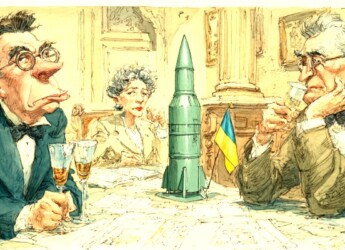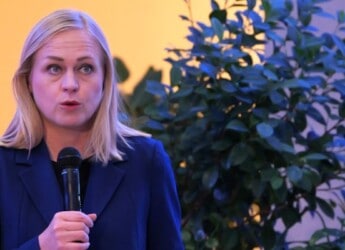Editor’s Note: In the shadow of ongoing hostilities, the details emerging from the Russian-Ukrainian peace negotiations in Istanbul in April 2022 shed light on the complex tapestry of geopolitical ambitions and strategic calculations that define the conflict. The Wall Street Journal’s recent revelations about the draft treaty from these negotiations offer a stark glimpse into Russia’s long-term objectives for Ukraine, painting a picture of a nation envisioned to be perpetually defenseless against future aggressions. This narrative of “demilitarization,” long propagated by the Kremlin, is now laid bare with concrete proposals that sought to cap Ukraine’s military capabilities drastically.
Source Note: One of the most accurate and detailed sources for ongoing updates on the Ukraine crisis is the Russian Offensive Campaign Assessment from the Institute for the Study of War. The Institute for the Study of War (ISW) is a 501(c)(3) organization and produces strictly non-partisan, non-ideological, fact-based research. ISW seeks to promote an informed understanding of war and military affairs through comprehensive, independent, and accessible open-source research and analysis. ISW’s research is made available to the general public, military practitioners, policymakers, and media members. Providing a daily synthesis of key events related to the Russian aggression against Ukraine, ISW updates may benefit investigators and litigators as they follow the business, information technology, and legal trends and trajectories impacted by and stemming from the current Russo-Ukrainian conflict.
For those seeking to grasp the full scope of this evolving landscape, the complete updates from the Institute for the Study of War serve as an invaluable resource.
Content Assessment: Eastern Europe at a Crossroads: The Strategic Implications of Russia-Ukraine Negotiations
Information - 94%
Insight - 95%
Relevance - 93%
Objectivity - 94%
Authority - 96%
94%
Excellent
A short percentage-based assessment of the qualitative benefit expressed as a percentage of positive reception of the recent article titled, "Eastern Europe at a Crossroads: The Strategic Implications of Russia-Ukraine Negotiations," by ComplexDiscovery OÜ and sourced from the Institute for the Study of War.
Russo-Ukrainian Conflict Update*
Eastern Europe at a Crossroads: The Strategic Implications of Russia-Ukraine Negotiations
ComplexDiscovery Staff
A Blueprint for Ukraine’s “Demilitarization”
In a revelation that has sent ripples through diplomatic circles, details from the Russian-Ukrainian peace negotiations in Istanbul in April 2022 have come to light, offering a stark glimpse into Russia’s long-term strategy for Ukraine. According to documents obtained by The Wall Street Journal, Russia envisioned a settlement that would drastically curtail Ukraine’s military capabilities, aiming to transform Ukraine into a “permanently neutral state” devoid of foreign military alliances, personnel, or armaments. The proposed caps on Ukraine’s military strength—85,000 soldiers, 342 tanks, and 519 artillery systems—stand in sharp contrast to Ukraine’s counter-proposal, reflecting a deep chasm in the security aspirations of both nations.
The Draft Treaty and its Strategic Consequences
The draft treaty unearthed from the 2022 negotiations not only sought to impose severe restrictions on Ukraine’s military but also intended to shape the geopolitical landscape to Russia’s advantage. By designating the United States, the United Kingdom, China, France, and potentially Belarus as guarantors, Russia aimed to create an international framework that would insulate it from the repercussions of future aggressions against Ukraine. This maneuver was evidently aimed at deterring Ukraine from seeking NATO membership, a move that would require constitutional amendments from Kyiv.
Unresolved Territorial Ambitions
The failure of Presidents Putin and Zelensky to agree on the status of Russian-occupied territories in eastern Ukraine underscores the broader territorial ambitions harbored by the Kremlin, ambitions that extend well beyond the confines of Donetsk and Luhansk oblasts. This deadlock, combined with Kremlin Spokesperson Dmitri Peskov’s assertion that the conditions have evolved since the draft agreement, signals Russia’s persistent pursuit of maximalist objectives in Ukraine.
Putin’s Pivot: Aligning with the Military and Veteran Community
In a strategic pivot, Russian President Vladimir Putin has sought to realign himself with the country’s military and veteran communities, distancing himself from the so-called Russian elite. His February 29 speech to the Federal Assembly was a clear departure from previous narratives, placing the military and workers at the heart of Russia’s elite. This rhetoric has resonated with ultranationalist milbloggers, signaling a potential shift in the social and political fabric of Russia.
Gagauzia: A New Front in Russia’s Geopolitical Strategy
On March 1, Kremlin officials engaged with leaders from the pro-Russian Moldovan autonomous region of Gagauzia, emphasizing support against what they describe as Moldovan “oppression.” This meeting, along with the signing of bilateral agreements, marks a significant step in Russia’s efforts to assert its influence in Moldova, mirroring its tactics in Transnistria. These developments suggest that the Kremlin is laying the groundwork for a broader geopolitical strategy in the region, one that may involve hybrid operations aimed at destabilizing Moldova to thwart its EU integration efforts.
A Decade of Bilateral Security Cooperation
In a move that underscores the international dimension of support for Ukraine, the country signed a 10-year bilateral security agreement with the Netherlands on March 1. This pact, bolstered by a Dutch commitment of 2 billion euros in military aid for 2024, prioritizes assistance in critical areas such as air defense, artillery, and naval capabilities. The agreement is a testament to the evolving landscape of international defense cooperation, highlighting the global stakes involved in the Ukrainian conflict.
Strategic Implications
The details emerging from the Russian-Ukrainian peace negotiations and subsequent developments paint a complex picture of the ongoing conflict. Russia’s strategic maneuvers—aimed at weakening Ukraine’s military, reshaping its geopolitical alliances, and asserting influence in neighboring regions—contrast sharply with the international community’s efforts to bolster Ukraine’s defense capabilities. As the situation unfolds, the strategic, diplomatic, and military implications of these developments will undoubtedly shape the future trajectory of the conflict, with far-reaching consequences for regional stability and international security.
News Sources
- Institute for the Study of War (understandingwar.org)
- The Battle Beyond the Battlefield: Information Warfare and Geopolitical Maneuvering (February 23, 2024)
As a leading source for cybersecurity, information governance, and legal discovery insights, including international investigations and litigation, ComplexDiscovery OÜ recognizes the importance of awareness regarding alleged and documented criminal acts, particularly in the context of the Russia-Ukraine conflict. While we, following the lead of the Institute for the Study of War (ISW), do not provide detailed coverage of war crimes in our primary reports, we encourage professionals within the eDiscovery ecosystem to stay informed about these activities. This awareness is crucial for understanding potential future legal actions and responsibilities.
Detailed Reporting with Maps for March 1, 2024, from the ISW – Mouseover to Scroll
Ukraine Update - March 1, 2024-ISWReview the Detailed Reporting and Maps PDF
About the Institute for the Study of War Research Methodology
ISW’s research methodology relies on both primary and secondary sources, enabling researchers to develop a comprehensive understanding of the situation on the ground. In order to analyze military and political developments in any given area, ISW’s research analysts must wholly understand the systems of enemy and friendly forces. They must also understand the population demographics, physical terrain, politics, and history of that area. This lays the analytical foundation for understanding the reasons for particular developments and fulfilling their assigned research objectives. ISW analysts also spend time in places like Iraq, Afghanistan, and elsewhere in order to gain a better understanding of the security and political situation and to evaluate the implementation of current strategies and policies. Our researchers compile data and analyze trends, producing a granular analysis of developments in areas of research, producing an accurate, high-resolution, timely, and thorough picture of the situation. ISW’s research methodology guarantees its success and commitment to improving the nation’s ability to execute military operations, achieve strategic objectives, and respond to emerging problems that may require the use of American military power.
About the Institute for the Study of War
The Institute for the Study of War advances an informed understanding of military affairs through reliable research, trusted analysis, and innovative education. We are committed to improving the nation’s ability to execute military operations and respond to emerging threats in order to achieve U.S. strategic objectives. ISW is a non-partisan, non-profit, public policy research organization.
Learn more, get involved, and contribute today.
Additional Reading
- From Dissent to OSINT? Understanding, Influencing, and Protecting Roles, Reputation, and Revenue
- [Annual Update] International Cyber Law in Practice: Interactive Toolkit
- Data Embassies: Sovereignty, Security, and Continuity for Nation-States
Assisted by GAI and LLM Technologies
* Sourced and shared with direct express permission from the Institute for the Study of War (ISW).
Source: ComplexDiscovery OÜ


























